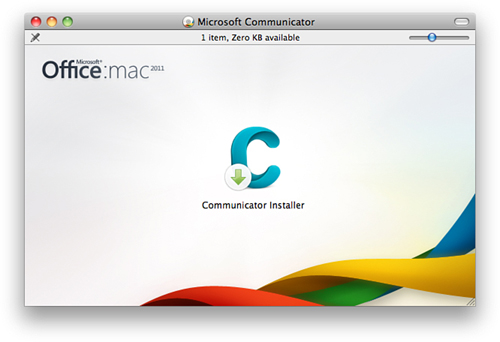Installing the Client
Although the Microsoft Communicator client for Macintosh integrates into the Office 2011 suite, it is actually a separate install. Given that most clients want to integrate the functions, we start with the steps for installing Office 2011 itself and then the Communicator client. To install Office 2011, perform the following steps:
1. Download the Microsoft Office 2011 installer. This is likely in the form of a .DMG file.
2. Double-click the .DMG file.
3. Double-click the Office Installer icon as shown in Figure 22.1.
Figure 22.1 Running the Office Installer

4. The installer offers to guide you through the install. Click Continue.
5. Read the licensing agreement and click Continue.
6. Click Agree to accept the license agreement.
7. The installer tells you which hard drive will be used for the installation. Click Change Install Location if you want to change installation locations or click Install to accept the recommended location.
8. When prompted, enter your password to authorize the installation. Click OK.
9. The installation prepares and a scrolling candy cane appears. Packages are validated and the installation commences.
10. When the installation completes successfully, click Close.
After the installation completes, the user is prompted to choose the licensing method: Either purchase a key online, enter a product key, or select a 30-day trial. Pick the option that is appropriate for your environment.
To install the Microsoft Communicator client, perform the following steps:
1. Download the Microsoft Communicator for Mac installer.
2. Double-click the .DMG file.
3. Double-click the Communicator Installer icon, as shown in Figure 22.2.
Figure 22.2 Running the Communicator Installer

4. The installer offers to guide you through the install. Click Continue.
5. Read the licensing agreement and click Continue.
6. Click Agree to accept the license agreement.
7. The installer tells you which hard drive will be used for the installation. Click Change Install Location if you want to change installation locations or click Install to accept the recommended location.
8. When prompted, enter your password to authorize the installation. Click OK.
9. The installation prepares and a scrolling candy cane appears. Packages are validated and the installation commences.
10. When the installation complete successfully, click Close.
There is now a big blue C icon in the chooser. Click it to launch Communicator.
When the Microsoft Communicator client launches, you will be asked to once again accept the license agreement. Click Accept. Communicator offers to make itself the default application for the following functions:
• Presence
• Telephone calls
• Conferences
For each offer, check the box marked Do not show this message again, and click Use Communicator.
After the offers process, Communicator launches. At the prompt, click Sign In and you are prompted to enter your Kerberos identity. Enter your logon name for Active Directory and click Continue. If this fails to find a Kerberos realm, click Cancel and you will instead be asked for the following information:
• E-mail address
• User ID
• Password
Although the wording is for E-mail address, if you are using a SIP address that doesn’t match your e-mail address, enter the SIP address instead.
If the DNS records are configured correctly to support Lync Server 2010, connect at this point to see the screen shown in Figure 22.3.
Figure 22.3 Connecting to Lync Server 2010

If the necessary SRV records are not present, the Communicator client has options to manually configure the connection; however, using the correct SRV records is the preferred method and it makes the client more transparent to the end user. To create the record in DNS, perform the steps:
1. From a Windows DNS server, click Start, Administrative Tools, DNS.
2. Expand the DNS server and expand Forward Lookup Zones.
3. In the zone that holds Lync Server 2010, right-click the zone and select Other New Records.
4. Choose a resource record type of SRV (Service Location) and click Create Record.
5. For Service, enter _sipinternaltls.
6. For Protocol, enter _tcp.
7. For Port Number, enter 5061.
8. For Host offering this service, enter the FQDN of the Lync Server 2010 Front End pool.
9. Leave Priority and Weight at the default values of 0 and click OK.
After the record propagates through DNS, Communicator clients should be able to connect correctly.
